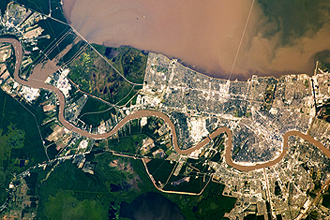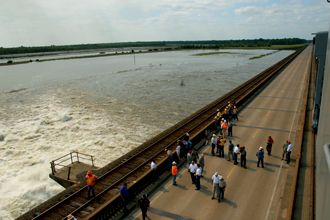Lesson From the Flood
If there is a take-home message from the Great Flood of 2011 it is this: Nature needs space, says environmentalist and Tulane law professor Oliver Houck. After spending more than a decade working to ensure that nature was afforded its due space in the Atchafalaya River Basin, he believes that people can “very happily live with nature as long as we don't put it in a box.”

The Bonnet Carre spillway (shown in the upper left) is located along the Mississippi River 12 miles upriver from New Orleans. This river control structure and the Morganza spillway, 35 miles upriver from Baton Rouge, were opened this spring to alleviate the threat of flooding in urban areas. (Satellite photo from NASA)
When the Army Corps of Engineers opened the bays of the Morganza River Control Structure last month, it diverted a significant portion of the swollen Mississippi River into the Atchafalaya Basin. While the diverted waters threatened the residences and commerce of thousands of people, the situation could have been far worse, says Houck.
Houck came to Louisiana in 1971 as an attorney for the National Wildlife Federation. At that time, “The corps was building a monster in the Atchafalaya,” says Houck. The corps wanted to dig a deep channel along the center of the Atchafalaya River while building levees along its banks.
But with Houck a key figure in the fight, sportsmen and environmental groups opposed the project in which the designated floodway, a flourishing swamp, would have been drained and destroyed to clear the way for development.

With the opening in May of the Morganza floodway as much as 114,000 cubic feet of water per second surges into the Atchafalaya River Basin. (Photo from the State of Louisiana)
After a decade of wrangling, the corps abandoned the channel project and obtained authority to purchase development rights across the basin. While landowners retain title to the land and oil, gas and timbers rights, they can't develop the land. And, unlike the Mississippi River, the Atchafalaya River has been allowed to flow to its natural banks, free from the constraint of levees and maintaining its biological productivity.
“Rivers are not gutters,” says Houck. The Atchafalaya River arrangement provides a reasonable model for how humans can live alongside rivers, he says. Setting development back by a couple of miles along the Mississippi River would not only protect populated areas from flooding, but also create extra storage capacity that could mitigate flooding downstream.
“Instead we built right to the river,” says Houck, “which simply isn't smart.”
